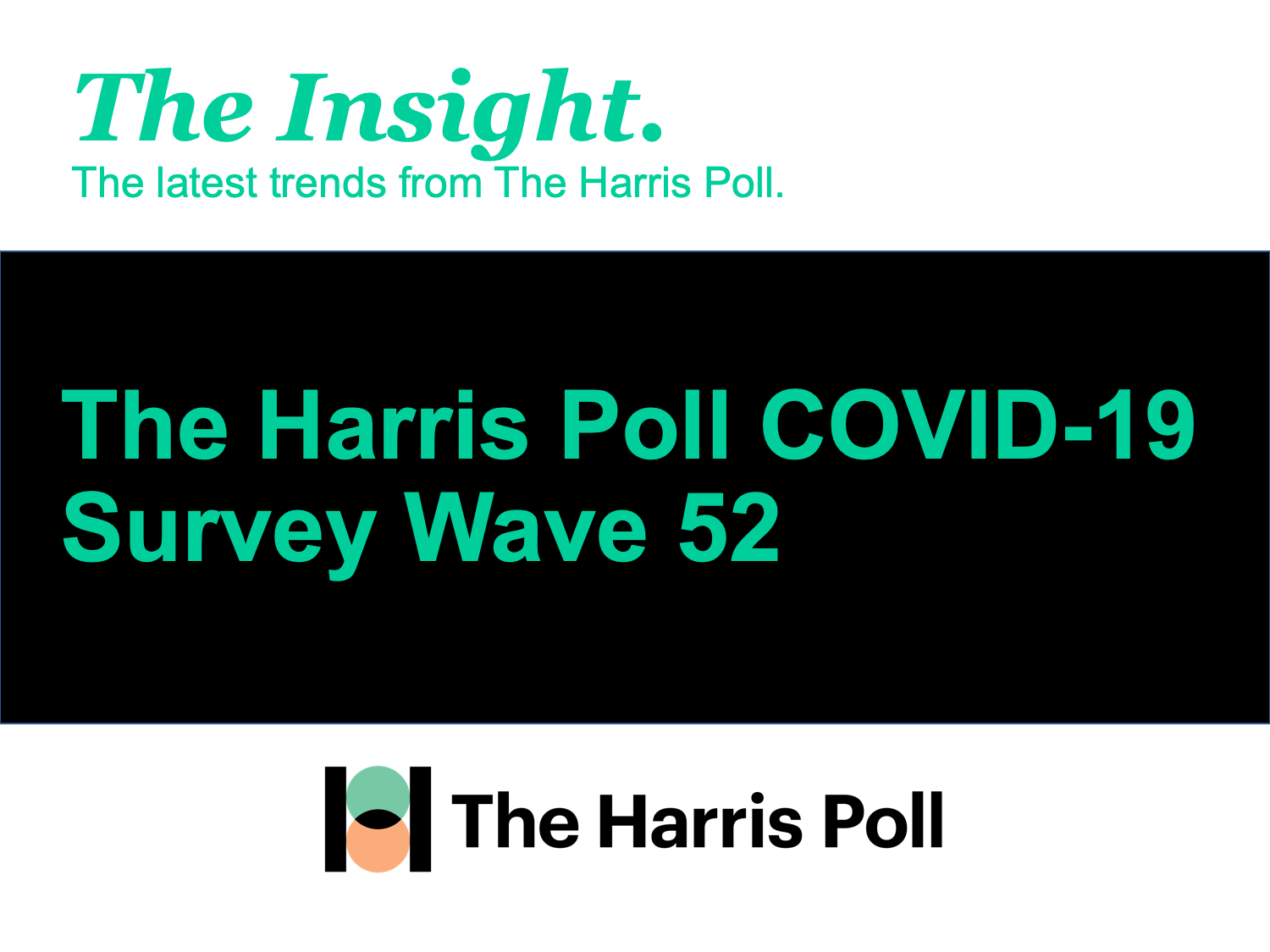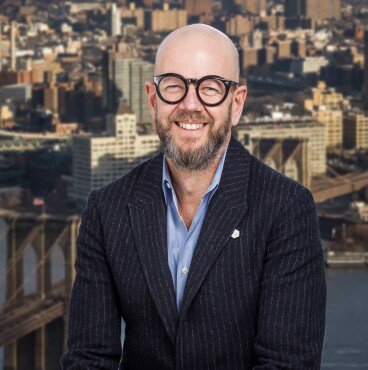Brief • 4 min Read

In The Harris Poll COVID-19 Tracker (Week 52) fielded February 19th to 21st, 2021 among 1,961 U.S. adults, we look at what Americans (don’t) know about Bitcoin, the impact of CEOs on consumer behavior, how many Americans don’t think COVID-19 vaccines even work, how Americans are neglecting their health during the pandemic, and the opportunity March Madness presents for major brands.
As a public service, our team has curated key insights to help leaders navigate COVID-19. Full survey results, tables, and weekly summaries can be accessed for free at The Harris Poll COVID-19 Portal. We will continue to actively field on a regular cadence to track the shifts in sentiment and behaviors as the news and guidelines evolve.
Americans Still Don’t Understand How Bitcoin Works: Bloomberg-Harris Poll
Mainstream financial institutions have started embracing cryptocurrencies. Main Street hasn’t. More than one in 10 American adults have never heard of cryptocurrencies such as Bitcoin, according to a new survey by The Harris Poll shared exclusively with Bloomberg. Here is what we found:
- Nearly half of respondents had only heard the names of those coins, whereas (16%) said they were very familiar with the cryptocurrencies and (28%) said they were somewhat familiar.
- Most people who have heard of cryptocurrencies don’t totally get them: (61%) of people who had heard of the coins said they had little or no understanding of how they work. Only (14%) of those familiar with crypto said they understand “very well” how they work.
- Trust remains another factor: among people familiar with cryptocurrencies, some (43%) expressed doubts about their legitimacy as a form of payment. And (29%) think crypto will largely be forgotten in 10 years, whereas (34%) believe it will become a standard form of payment.
- Across demographic groups, age wasn’t necessarily the biggest indicator of faith in crypto: while (58%) of Gen Z who knew about crypto said they thought digital currencies were very or somewhat legitimate as a form of payment, this figure rose to (69%) for Millennials.
Takeaway: In recent months, companies such Tesla have said they plan to begin processing payments in cryptocurrencies. However, few people actually use bitcoin to make purchases: nly (10%) of people familiar with crypto said they regularly make purchases with it. “From the public standpoint, it’s not a cryptocurrency, it’s a cryptic-currency,” said John Gerzema, CEO of The Harris Poll.
More Than Half Of All Consumers Change Buying Habits Based On CEO Actions
Half of Americans have changed their buying habits due to a CEO’s actions, young people believe employees, not customers, are a CEO’s highest priority, and consumers are divided based on age and ethnicity on the role a chief executive should play on social issues.
In a new Harris Poll survey in conjunction with The Stagwell Group, CEOs today have an oversized impact on their company’s reputation. In fact, half of all consumers say they have changed their buying decisions based on the actions of a CEO. Earlier this week, Harris Poll CEO John Gerzema and Vice Chair of The Stagwell Group Ray Day gave a webinar on why CEO reputation matters.
CEOs are becoming more visible and their actions more directly linked to the success or failure of their companies – from products and services to reputations, the study shows.
- (85%) of Americans say the CEO has an oversized impact on the reputation of a company today;
- Ethical standards are the highest-valued CEO quality – ahead of company vision and products and services;
- Humility is undervalued among CEOs today, and (72%) of Boomers believe there is more risk than reward in CEOs speaking out on social issues, while (56%) of Gen Z and (55%) of Black Americans say just the opposite.
As with many things, Americans are divided and disagree on how a CEO should engage with stakeholders and speak out on issues. Boomers, White Americans, and Republicans are clear about focusing on business and staying away from issues:
- (61%) of Boomers think it is bad for companies when CEOs become more active in expressing political views;
- (65%) of White Americans think that CEOs speaking out puts them in an “unwinnable” situation, bound to alienate and frustrate some stakeholders;
- And (49%) of Republicans think CEOs aren’t politicians and should stay out of political issues.
At the same time, appealing to younger, Black Americans, and Democrats requires a different approach:
- (31%) of Millennials purchase stock based on whether a company shares their values;
- (41%) of Black Americans think it’s better to take a stand on issues than not, even if it offends some;
- And (42%) of Democrats think CEOs are responsible for expressing the values of their companies, even if that brings alienation or controversy.
Alienation is a risk in a highly polarized society, but so too is the risk of stakeholders who perceive CEOs as indifferent or in conflict with the company’s principles.This is especially true among younger and Black Americans. While standing down is expedient, a generational and cultural divide is growing that will make decisions more difficult and polarizing.
Today’s CEO has reputational capital: She or he influences sales, perceived product/service quality and signals the strength of culture. As CEO reputation extends ever-outward, when to exert influence in society becomes more calculated and more important.
Takeaway: CEO reputation today means more than mastery of the marketplace. It requires a leader’s commitment to serve society. With that comes the burden of leadership: The public believes CEOs should stand on issues where they have credibility and constituency and be wary of wading into issues where they don’t have a voice or authority. Ultimately, core values should be the navigator of social issues.
Some Americans Still Don’t Think the Vaccines Work
The vaccine rollout in America continues, though one-third (32%) tell us they are not likely to take the vaccine. In our latest survey, we asked Americans how effective they think the vaccines are at preventing death, hospitalization, and transmission. Despite increasing real-time evidence that existing vaccines are extremely successful at preventing deaths and hospitalizations – and transmission to a lesser extent – many Americans aren’t buying it:
- One-quarter (24%) of Americans say existing COVID-19 vaccines are not effective at preventing death due to COVID-19 complications (and another 41% say they are only somewhat effective; 35% say very effective). Skepticism is highest among Gen Z (37% say not effective), Millennials and Black Americans (both 31%).
- A similar number (22%) say the vaccines are not effective at preventing them from being hospitalized due to severe illness from COVID-19.
- Some say “why bother”: More than one-quarter (27%) of Americans say existing COVID-19 vaccines are not effective at preventing them from catching and transmitting the virus to others. And just over one-third (35%) of those unlikely to get the vaccine (and 18% of the general public) say they won’t get the vaccine because it won’t prevent them from catching COVID-19 anyway.
- Effective messengers: two-thirds (66%) of Americans say the CDC has done a good job explaining the safety and risks of the vaccines (only 24% say they have done a poor job; 10% aren’t sure), while only (54%) say the media has done a good job. More than one-third (35%) say they have done a poor job and 11% aren’t sure.
Takeaway: David Leonhardt at the New York Times unpacks “vaccine alarmism” around the vaccine’s relatively small shortcomings: “much of this message has some basis in truth, but it is fundamentally misleading. The evidence so far suggests that a full dose of the vaccine […] effectively eliminates the risk of death, nearly eliminates the risk of hospitalization, and drastically reduces a person’s ability to infect somebody else. Yet the alarmism continues. And now we are seeing its real-world costs: Many people don’t want to get the vaccine partly because it sounds so ineffectual.”
Americans Are Neglecting Their Health: Time-Harris Poll
There’s more than one way to get sick during the COVID-19 pandemic. You can contract the virus, of course, as more than 28 million Americans already have. Or you can dodge the disease but still suffer from the disruption caused by quarantines and social distancing, if they lead you to neglect routine health care. That, a new TIME-Harris Poll shows, is just what too many of us are doing:
- The top-line numbers are sobering: (78%) of Americans have put off at least some medical services during the pandemic. Of those procedures, dental exams or cleanings were the most frequently missed, with (30%) saying that they have passed on regular oral care. Annual physical check-ups were next at (27%), followed by eye exams at (25%).
- Demographics play a significant role in who is staying current with health care during the pandemic and who is letting things slide. Only (16%) of people with a high school education or less have put off their routine check-ups during the pandemic, compared to (31%) of people with some college and (34%) of college graduates.
- As with so many things, race and ethnicity play a significant role as well, with communities of color suffering more – often lacking health insurance and working in lower income jobs. Among white Americans, (20%) report missing their annual check-ups during the pandemic, compared to (29%) of Black Americans and 48% of Hispanic Americans.
- Unexpectedly, mental health services, which would seem like the kind of care that most lends itself to telehealth since it so often involves nothing more than a conversation has lagged. Among all respondents, only (24%) said they were currently receiving mental health care, down from (29%) before the outbreak.
- Some positive findings are buried among the more concerning ones, much of them regarding telehealth, which is clearly experiencing a boom: only (29%) of people reported receiving some of their health care online prior to the pandemic; that figure jumped to (51%) during the pandemic era.
Takeaway: It’s too early to tell how the health care landscape will change after the pandemic is at last over. For example, some who have picked up telehealth may decide they like it and stick with it. Others may decide they prefer the old face-to-face model. What it’s not too early to say is that a country that already suffers from too much chronic illness will be wise to return at least to its pre-pandemic levels of doctor visits when the pandemic is in the rear-view mirror.
Harris Poll CEO Will Johnson: It’s Time for Major Brands to Come Off the Bench and Get Back in the Game
Pent-up demand for college basketball is creating an opportunity for advertisers around March Madness. After major brands like Coca-Cola, Budweiser and Pepsi sat out of the Super Bowl, Harris Poll CEO Will Johnson wrote an op-ed for AdAge detailing our survey findings on why brands need to take a shot at advertising during this year’s tournament—and how they should approach their ads. Here’s what he has to say:
- Americans are more amped up for this year’s tournament: Most Americans who plan to watch the games this year (53%, including 58% of men and 65% of Millennials) describe themselves as more excited for this year’s tournament than they were for last year’s before it was canceled.
- That excitement is reflected in viewing plans: While only (39%) of Americans watched any of the 2019 March Madness tournament, (46%) intend to do so this year. Half of men watched two years ago, but (60%) plan to do so this year.
- Viewers want brands to be upbeat: When we asked those who plan to watch what kind of mood they would like to see TV ads express during game breaks, the three most frequent answers were “optimistic” (51%), “lively or energetic” (49%), and “funny” (47%), and it wasn’t close: “Nostalgic” was a distant fourth at (23%).
- Viewers want ads to be relatable: In terms of the specific types of content that will appeal to them, viewers say they want to see ads with situations or jokes which reflect their everyday lives (44%) and they want ads showing people helping others (43%).
- Star power isn’t so powerful: A majority of those who plan to watch the games (55%) say that ordinary people appearing in the ads would most appeal to them, and 41% said they wanted to see ethnically or racially diverse ads. Athletes (30%) and celebrities (29%) were markedly less popular choices, bringing up the rear with American viewers.
Takeaway: Consumers want relatable reality rather than Hollywood glitz in the breaks when watching March Madness this year. This should be a lay-up for advertisers – at least the ones who are carefully listening.
Subscribe for more Insights
Subscribe to our newsletter for the latest trends in business, politics, culture, and more.
Download the Data
This survey was conducted online within the U.S. by The Harris Poll from February 19 to 21, among a nationally representative sample of 1,984 US. adults.
Download
Subscribe for more Insights
Subscribe to our newsletter for the latest trends in business, politics, culture, and more.
Download the Data
This survey was conducted online within the U.S. by The Harris Poll from February 19 to 21, among a nationally representative sample of 1,984 US. adults.
DownloadRelated Content








